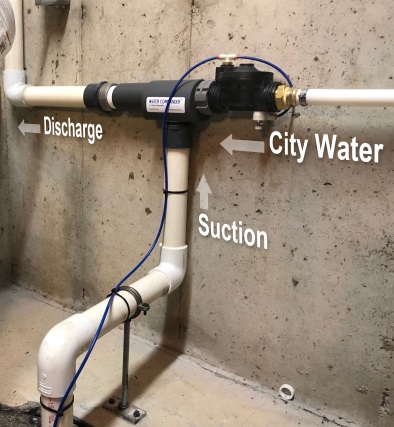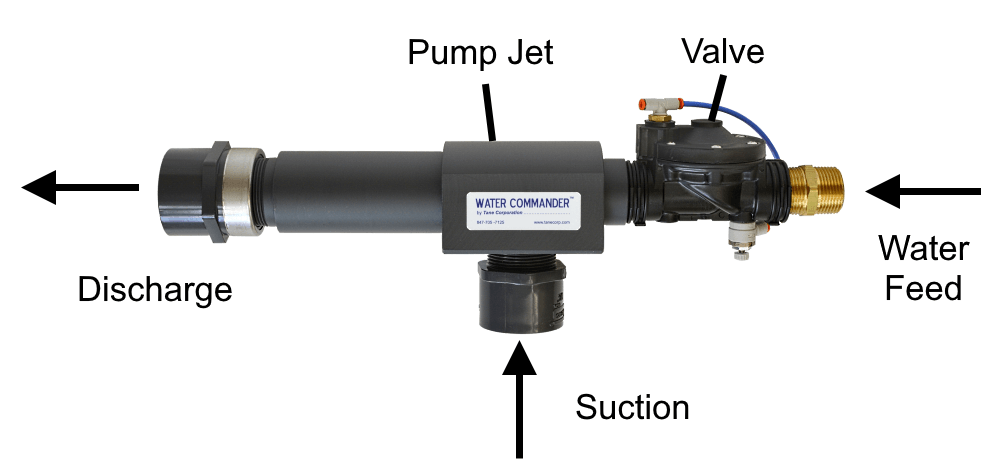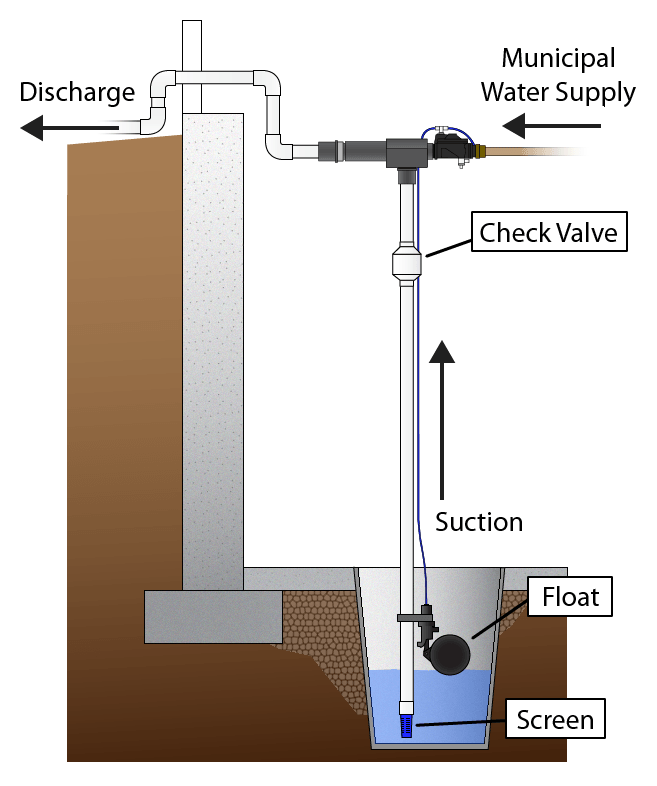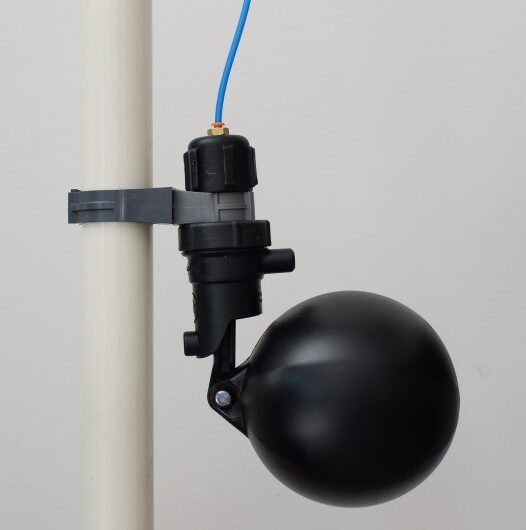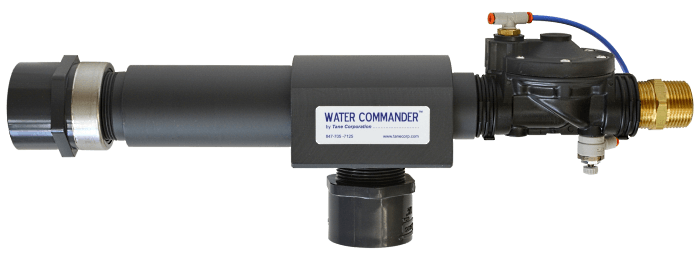Everything you need to know about water-powered sump pumps.
Over the past several decades, backup sump pumps powered only by your home’s municipal water pressure have grown in popularity as an alternative option to battery-powered emergency backup sump pump systems. Water-powered backup sump pumps are a unique and inventive solution to protecting your basement from flooding during power outages or primary sump pump failures.
As homeowners have discovered the deficiencies of battery backup sump pumps — namely their limited run time and propensity to fail during prolonged rain storms—Water Commander™ water-powered sump pumps as emergency backups have gained a devoted following since they are much more reliable.
We cover each of the topics below:
- Best Water-Powered Backup Sump Pump
- How Water-Powered Sump Pumps Work
- Pump Installation
- Benefits of Water-Powered vs Battery Backups
- How Much Water Does It Use?
- Additional Resources
Best Water-Powered Backup Sump Pump
The best water-powered backup sump pump by far is Water Commander™.
Water Commander’s ultra-performance model, model MG36, is able to pump faster than high-end battery backups and 2-3x more than any other water-powered backup. The high-performance model MG22 also pumps more than any other brand and is installed in thousands of homes across the country. All Water Commander™ pumps are individually hand-assembled from top quality, heavy-duty parts to ensure you won’t experience performance or leaking problems common with other cheaper pumps.
The 1-minute video below shows just how fast Water Commander™ pumps, close to 40 gallons per minute at 60 PSI. Having a pump like Water Commander™ that can handle significant amounts of water flowing into your sump can be the difference between a dry basement and a flooded basement during a bad rain storm.
Check out our pump model page to see Water Commander™ pumping rates, or read our article “Best Water-Powered Backup Sump Pump?” that explains in more detail why Water Commander™ is the best water-powered backup available.
How Water-Powered Sump Pumps Work
Unlike battery backup sump pumps that use a motor and impeller to push water out of your sump pit, water-powered sump pumps harness your home’s municipal water pressure to create a strong vacuum, siphoning water up from your sump and quickly discharge it outside your home.
Water-powered sump pumps include both the suction generating pump, which consists of an automatic valve / ejector jet unit, and a float assembly. As you can see in the photo to the right, the pump connects to your home’s municipal water line, suction pipe, and discharge pipe.
Rising water in your sump lifts the float, automatically opening the valve and allowing municipal water to flow through the pump’s ejector jet. Inside this jet is a nozzle and chamber that converts the water pressure into a vacuum. Like any vacuum pump, the low internal pressure is much lower than the external atmospheric pressure, effectively creating a strong suction that quickly empties your sump pit.
For a more detailed explanation, including photos and animations showing how it works, view our video above or visit our article: How Do Water-Powered Sump Pumps Work?
Pump Installation
The diagram below illustrates a basic Water Commander™ water-powered sump pump installation common in many homes.
The pump has to be connected to your home’s water supply, generally a 3/4″ or 1″ line. A suction pipe descends from the pump into the sump pit, while a discharge pipe brings the water out of the home. A screen at the bottom of the suction pipe keeps large debris in your pit from flowing up into your pump. Also, a check valve on the suction pipe ensures water does not flow back into the sump. In many areas, a backflow preventer (dual check valve or Watts 9D style) is required on the water supply line as well.
Within the sump itself, a float switch is attached to the suction pipe. This float should be positioned above the primary electric pump so it only runs when the primary pump is overwhelmed or is no longer working.
For photos of actual installations of Water Commander™ and more detailed install steps, please visit our Installation page.
Benefits of Water-Powered vs Battery Backups
There are several important benefits that water-powered backup sump pumps have.
1. Water-powered sump pumps will never lose power or have reduced pumping rates. Battery backup sump pumps have a finite run-time (with a fresh battery, usually 5–7 hours of continuous use and longer if only run intermittently). Water-powered sump pumps, on the other hand, require no batteries and have a much more reliable source of power–your home’s municipal water pressure. They can be depended on to pump at the same high rates whenever needed. If you have a battery backup, it may be running great one moment, but the pump could quickly slow and then die once the battery is depleted. (See our video, How Long Does a Backup Sump Pump Battery Last?)
2. Along similar terms, since water-powered sump pumps do not use a battery, this equals significant cost savings over the life of the pump. If you own a battery backup system, you should be replacing your battery around every three years. Each battery can cost around $200 including battery acid. With water-powered pumps, there’s nothing to replace or maintain.
3. Water Commander™ water-powered sump pumps can pump at rates equal to or higher than a high-end battery backup, without the risk of losing power. Unlike other cheaper water-powered sump pumps, Water Commander™ model MG22 can pump up to 1,800 GPH (gallons per hour) at a 10 foot lift, while our model MG36 can pump up to 2,830 GPH. For comparison, at the same 10 foot lift, typical 1/4 HP electric backup sump pump will pump around 1,000 GPH, while a higher-end 1/3 HP electric pumps can pump up to 1,800 GPH.
Our articles, Water-Powered vs Battery Backup Sump Pumps and also Pros and Cons of Water-Powered Sump Pumps, both go into more detail covering some of the benefits of water-powered sump pumps.
How Much Water Does It Use?
Water Commander™ uses 1 gallon of municipal water to pump 2 gallons of water out from your sump pit. Water-powered sump pumps are emergency backups, so they only run when you need them most during power outages or primary pump failure. For an entire year, the amount of water required for an average homeowner would be comparable to running your lawn sprinkler for just several hours. That minimal water consumption is more than worth it, considering the huge cost you would incur from a flooded basement.
Read more in our article, How Much Water Does a Water-Powered Sump Pump Use?
Additional Resources
- Not convinced you need an emergency backup? Read Why You Need a Backup Sump Pump.
- Test Your Water Pressure: Water-powered sump pumps require municipal water (instead of a well) and water pressure greater than 40 PSI. To determine how much water-pressure you have, you can test it yourself on a standard hose bib with a water pressure gage (like this one). This how-to also explains the “bucket” method if you don’t have a gauge.
Learn More
If you’re trying to determine if a Water Commander™ water-powered backup sump pump is right for you, visit the rest of our website or contact us. We’d be happy to answer any questions and determine if Water Commander™ is a good solution for your home!
Looking for a quality backup sump pump?
Water Commander™ is the best backup sump pump system available on the market today. It’s non-electric, can out-pump your electric sump pump, and will run at full power for years to come.
It is more reliable than battery backups and is the perfect solution for homes with municipal water.
Top Posts
- Water-Powered vs Battery Backup Sump Pumps
- How Long Does a Backup Sump Pump Battery Last?
- How Do Water-Powered Sump Pumps Work?
- How Much Water Does a Water-Powered Sump Pump Use?
- Why Independent Discharge for Your Backup Sump Pump Is Best
Recent Posts
- How To Measure Your Home’s Water Pressure
- Why Is My Sump Pump Not Working?
- How to Prevent Basement Flooding
- Battery Backup Sump Pump Troubleshooting Guide
- My Battery Backup Sump Pump Alarm Won’t Stop Beeping (Fixes)
Categories
Tag Cloud
Alarm Backup Sump Pump Batteries Basement Flooding Beeping Bernoulli Principle Best Sump Pump Check Valves Crawlspace Discharge Pipes Drain Tiles Ejector Jet Float Assembly Independent Discharge Municipal Water Perforated Sump Pits Power Outages Primary Sump Pump Failure Pros and Cons Pumping Charts Pumping Efficiency Pumping Rates Pump Life Span Pump Run Time Pump Testing Radon Gas Suction Pipe Sump Basin Sump Pump Motor Sump Pump Switch Troubleshooting Ultimate Guide Venturi Effect Water Drainage Systems Water Pressure Water Pressure Gauge Water Usage
